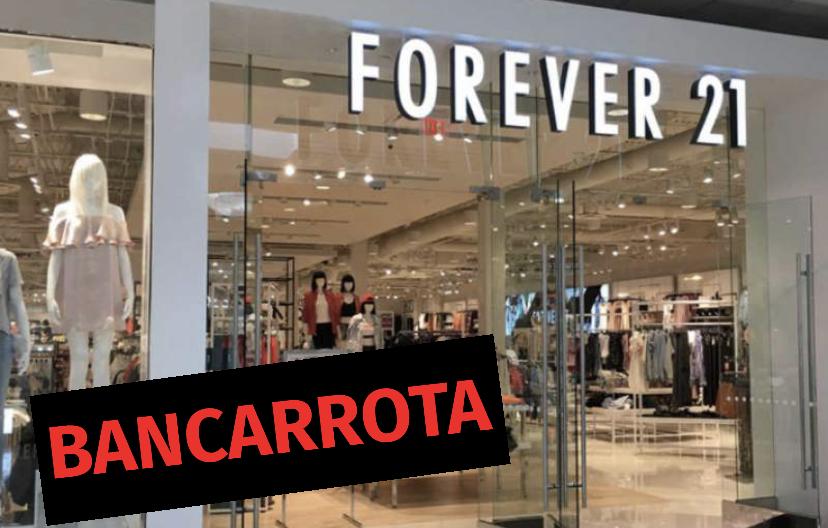And to all this, why did Forever 21 go bankrupt?
In November 2010, as businesses of all kinds closed their doors, Forever 21 opened a new store on Fifth Avenue in New York. Against the grain, the fast fashion pioneer brand grew and brought fast fashion to the biggest spaces in the best locations.
During the following years the expansion was frantic: in 2012 it opened its most expensive store in Hong Kong with a monthly rent of one million 400 thousand dollars. And it wasn't even the company's largest store, that was a nearly 1,400-square-foot store in Fresno, California.
The rhythm of openings and ribbon cuttings reached London, Mexico City, Prague, Warsaw, Bucharest, Beirut, Tokyo, Shanghai, Beijing, Manila, Rio de Janeiro, Santiago, Cape Town, Sydney. And in the process, the store became a crucial tenant for mall owners.
At its peak, in 2014, the company generated about $4 billion in revenue. Big world and big money but on the inside, Forever 21 was secretive and hierarchical, 99 percent owned by Do Won Chang and his wife, Jin Sook, who founded the company in Los Angeles in 1984, just a few years after they arrived from South Korea.
Now we know that as early as 2016, when the Changs operated 522 stores in the United States and more than 200 in 43 other countries, there were problems. Sales didn't grow that year, high-profile international stores were unprofitable, and the company quietly closed some stores and downsized space in others. Exploring a second front, in 2017 she launched Riley Rose, a beauty and lifestyle emporium featuring South Korean products. Although the proposition was good, so was the competition, and those stores would also lose money. In early 2019, Forever 21 sold its Los Angeles headquarters for $166 million. For the summer I had almost no money.
The bankruptcy, which occurred in September, was the result of years of poor decisions and a fundamental lack of understanding, not only of the change retail was going through, but of its conventions as well. Forever 21 has left Canada and Europe, and is withdrawing into Asia and Latin America. In the United States, it will close 111 stores. If it survives, it will be with fewer stores, fewer employees, and more manageable ambitions. But that more modest future likely depends on the Changs relinquishing control. If they don't, Forever 21 may not even have a future.
For a long time, the couple controlled everything, with Mr. Chang overseeing the operations and Ms. Chang selecting the merchandise, assisted by another Korean-American couple, Alex and SeongEun Kim Ok, who hold the remaining one percent stake. of the company. By 2009, two new members joined that inner circle: the Changs' daughters. Linda, who studied business at the University of Pennsylvania and took over marketing; and Esther, the youngest daughter and Cornell graduate, vice president of merchandising.
Although Forever 21 did not allow any of its executives to be interviewed for this article, the bankruptcy filing is itself revealing; In addition, more than a dozen people shared their stories about working at or with the company. There are sources that we keep anonymous because of the confidentiality agreements they signed.
The very essence of fast fashion calls for clothing to be of the moment, a less expensive reflection of a current style, but not an exact replica. Despite this, in the last 20 years, designers such as Diane von Furstenberg, Anna Sui and Gucci have filed at least 250 cases in federal court accusing Forever 21 of intellectual property theft. The way in which it deals with these disputes has usually been to reach an agreement. It's rare for any piece of clothing at Forever 21 to cost more than $60, and most sell for much less. But being trendy and cheap is not enough, it must also be fast fashion. To satiate the hunger for novelty, its stores displayed new clothing almost daily, drawing in customers—a good thing for Forever 21 and for malls. The firm, on the other hand, didn't put much thought into the online shopping experience, which was bad for the company but, again, good for the malls.

As the Changs grew from one shop to ten, then a hundred and nearly eight hundred, they created a culture in which authority rested in a few hands. Mr. Chang oversaw the expenses and Ms. Chang authorized each item. Interactions between departments were limited and information was shared sparingly. Some former executives don't remember Do Won Chang ever stopping by their office or sending them an email. The owners seemed unapproachable. Employees rarely saw them. The Changs trusted a small group of people, most of them Korean-Americans or members of their evangelical church. Having a high position did not give certainty either, sometimes executives were fired or demoted without much justification. It was, says one of them, like being on a Korean reality show.
"It was a business that, frankly, I don't think was run particularly well. But they managed to run for a while," says Neil Stern of retail consulting firm McMillanDoolittle. Like many in the industry, he noted the high turnover in the company's executives. "It's hard to go into a family business, because, at the end of the day, how much control can you have?"
The Changs dreamed of turning Forever 21 into a department store at a time when that concept was showing signs of exhaustion. The company moved quickly into vacant spaces in Chicago, Houston, Las Vegas, Philadelphia and dozens of other US cities.
"Their funding was unclear and their appetite for space was undisciplined," says Jim Sullivan of financial firm BTIG.
Either way, the mall owners delivered what they asked for. "When they want large premises, you give them large premises", adds the specialist.
But filling those large gaps turned out to be much more difficult than the Changs anticipated. And operating in dozens of countries on six continents required expertise they didn't have. At the company's heyday, just 20 people in Los Angeles ran the empire. And the annual sales projections seemed to be based more on instinct than data. They ordered too much merchandise one year and too little the next: in the bankruptcy filing this was called "the pendulum effect." In 2018 they ordered too much. Store managers complained that their warehouses could not accommodate the daily batches. Some stacked the boxes of clothes in the changing rooms. They eventually had to ship them back to the distribution center, where the company sometimes lost track of them. This lack of coordination caused even deliveries to take weeks, which in the world of fast fashion are equivalent to months.
Due to being rushed or slow, or both, Forever 21 hired import agents who overlooked important details. Former executives say that shipments to Brazil were held up at customs because the company did not have a license to import footwear. The staff had to go through the bins to find the shoes and then destroy them. Forever 21 had to do the same with cosmetics on its way to Brazil and Mexico.
They didn't adjust their marketing strategy either. They ordered coats for all the stores, although if it was winter in North America, that meant summer in South America. They bought clothing that was too revealing for the Middle East and Latin America and too large in size for Asia. "They didn't tailor the product for the specific market," Sullivan explains of that problem. Add to that growing competition from online-only brands like Asos and Fashion Nova, and declining sales at malls.
In recent years, the firm has faced another fundamental problem: the decline of fast fashion. Fewer people want to buy disposable clothing. The quality is very low and the cost to the environment is very high. "Forever 21 doesn't seem to have accepted the new awareness of fashion's contribution to global warming and pollution," says Susan Scafidi, director of the Fashion Law Institute, a center dedicated to legal issues in the fashion industry.
All these changes in consumption left the chain with a huge amount of clothing that it could not sell at regular price. Any other retailer lowers prices until the garments are sold and takes a loss on what was not sold. But Mr. Chang approached the situation differently.
Retailers use their inventory, often the only tangible asset they own, as collateral for loans. If Chang allowed the clothes to be offered at a discount, their value would drop, as would the amount of money the company could borrow. So he stored it. His strategy may have helped in the short term, but not in the long term.
So the spring of 2019 arrived with an alarming fact: sales fell 20 percent compared to the previous year. Chang, implausibly planning to open more stores, took the advice of his new CFO Brad Sell and decided to close 100. Troubled to pay the rent on the premises, it also had to close the least profitable stores in Europe and Asia. Its operations on those continents and Canada collectively reported losses of $10 million each month from the fall of 2018 to the same period in 2019.
Negotiating with mall owners in the United States was difficult. Before agreeing to a deal, they insisted on first seeing a plan to revive the company, and when none was presented to them, they refused to help. Troubled, the retailer turned to asset management firm Lazard Ltd. and other advisers and lawyers to find out how to restructure the company and keep it under family control.
Bankruptcy loomed, but the new advisers hoped they could reach an agreement with creditors by the time the company filed for Chapter 11 bankruptcy in the United States.
That task was complicated by the Changs' business practices.
Former executives say the company used outdated software and accounting and shipping systems were a mess.
Shops sometimes transferred merchandise on their own, and warehouses stockpiled years-old clothing. What was happening could have been manageable if the Changs had agreed to step aside, but no.
When Forever 21 filed for bankruptcy on September 29, there was no settlement with the owners. Just a few days earlier, they had their locks changed on the store in the Houston Galleria mall: The retailer owed nearly $148,000 in back rent. As of today, in bankruptcy proceedings, Forever 21 has secured more than $100 million in rent reductions for US stores and has reopened the Galleria location.
That rent relief has also allowed it to keep open 60 stores it initially planned to close.
Riley Rose has given up spaces she rented and closed her independent website. Their operations will be incorporated into Forever 21. No one knows what the laid off employees will receive. "We just hope they're doing what's best for everyone and not just protecting their pocketbook," says Andrew Upton, who works at a Forever 21 store in Bakersfield, California.
The purpose of filing for bankruptcy is to protect a business from creditors while it devises a restructuring plan. The plan, of course, has to offer to pay creditors at least some of their money or give them a stake in the restructured business. If creditors don't approve the plan, they can force a company into liquidation, as happened with Toys "R" Us. If the owner is reluctant to give up their stake, that can create a deadlock, as is happening with Forever 21.




